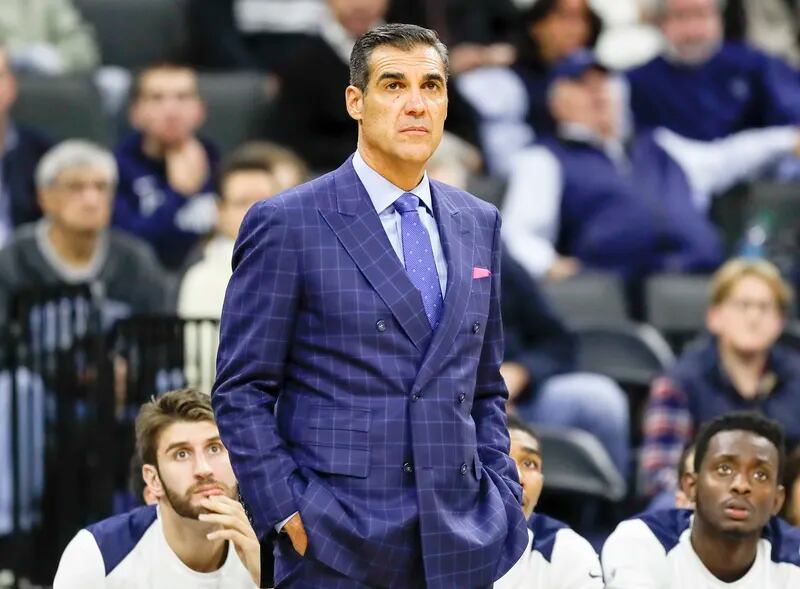Photo credit: Yong Kim (Philadelphia Inquirer)
By Liam O’Murchu (@Liam_0__)
When you flip the channel to a basketball game, the first thing you notice is likely to be the players. Then maybe it’s the number of empty seats in the crowd or the design of the court. But in the background sits (or stands, depending on the stress levels of the game) the coaching staff, who have quietly gone through a transformation in attire in recent years.
Before the COVID-19 pandemic, nearly every basketball coach, college and professional, wore a suit and tie. But in the summer of 2020 when the NBA was returning, they did so in Disney World with an intensive testing protocol and no fans in the stands. With the combination of no spectators, Florida summer temperatures, and high-stakes games, the league allowed coaches to swap the suit for a quarter zip or polo shirt.
As is the case with trends on the court, the NBA set the tone for the rest of the basketball world and college coaches began the season in less formal attire than before the pandemic. Although the NCAA didn’t impose regulations on what coaches could wear like the NBA, it didn’t matter as the vast majority of coaches opted for comfort over formal wear.
Even when fans returned to arenas, most coaches neglected to revert back to the suit, although the exceptions (such as former national champion Rick Pitino) were outspoken in their criticism of the lack of professionalism shown by coaches.
Jay Wright, two-time national champion and former Villanova head coach, is perhaps the modern college basketball coach most synonymous with his well-tailored suits, earning the title of “best dressed man in college basketball” from President Barack Obama in 2016. So when he abandoned the suit heading into the 2020-21 season, many of his colleagues followed suit (pun intended).
When GW men’s basketball head coach Chris Caputo was hired in April 2022, he was faced with the decision of whether he and his coaching staff should wear suits on the sidelines at an inflection point in the debate across the country. He’d amassed 20 years of coaching experience, all of which was spent donning suits until the pandemic. On one hand, he felt like wearing a suit was important to representing the university as well as possible and showing that being a basketball coach was a “real job.” But he also recognized that wearing a suit 2-3 times a week could be difficult for some of the younger members of the staff who are getting paid very little.
”The amount of money you spend in dry cleaning and the amount of suits you need to have can make it difficult for some of the junior staff members who aren’t making the same amount of money as the head coaches.” Caputo said. “It might ease their finances a little bit and also allow for some uniformity in terms of everyone wearing something with the GW logo on it.”
Ultimately Caputo opted for the quarter zips but made sure to emphasize the importance of everyone wearing the same style of clothing rather than half the staff wearing suits and the other half wearing t-shirts.

Photo credit: GW Athletics
The former George Mason and Miami assistant coach also mentioned the different dynamics of picking out suits as an assistant than picking one out as a head coach. As an assistant, he never wanted to stand out, but the head coach is expected to have a high quality tailored suit.
“When I wore suits, I tried to wear a nice suit in terms of, I wanted to kind of be invisible.” Caputo said. “I didn’t want anybody to look at me and say ‘look at that fancy outfit he’s wearing’ or I didn’t want anybody to say ‘that guy looks like he’s a mess.’”
Another added benefit is the ability to pack lighter for an extended road trip, although this is more of a factor for professional coaches than it is for those in the college ranks who don’t embark on roadtrips of the same length as their professional compatriots. Caputo said he’s spoken with NBA head coaches who are forced to bring five or six different suits on a 10 day road trip, which accounts for an entire bag solely for their suits.
In a world where more people are working from home than ever before, athleisure clothes are seeping into the daily routines of people outside basketball as well. When given the choice to wear a t-shirt or a button down, the choice is clear to many, although some have pushed back out of principle more than anything else.
Richmond head coach Chris Mooney remains a strong proponent of formal wear even as many of his colleagues moved away from it and told me he wasn’t entirely sure why coaches stopped wearing suits after it’d become a tradition.
“I didn’t know why people dressed down.” Mooney said. “I still don’t necessarily understand that. We dressed up for 100 years. For me it’s that, one I represent Richmond, and I feel like that’s the best way to do it. And then two, it’s just a rejection of those who don’t think we need to do it.”

Photo credit: Alexa Welch Edlund (Richmond Times Dispatch)
As notable and sharp as the shift away from suits has been, the establishment of suits on the sidelines deserves some mention as well. Basketball was in a unique position in terms of coaching attire pre-2020. The only other sport in which coaches regularly wear suits is ice hockey, where the coaches spend the majority of the game standing still next to a sheet of ice. Meanwhile, basketball coaches storm up and down the sideline, shouting instructions to players and breaking a sweat in crowded and hot arenas.
The tradition began with James Naismith, the inventor of basketball, who wore a wool suit. From there it took on a life of its own as legendary coaches like John Wooden and Dean Smith led their teams to national championships dressed in nice suits as future generations of coaches watched on.
Simply put, very few coaches had the courage to go against the grain and wear something other than the standard suit and tie. Of course, those that did stuck out. Bob Knight wore a polo shirt the night he was ejected for throwing a chair across the floor mid-game. Bob Huggins’ signature look was a pullover, and when asked why he never wore a suit, he famously remarked “because I’m not a banker. Why would I dress like one?”
But at some places, the decision of what to wear is out of the hands of the coach. Tony Bennett made a habit of not wearing a tie when he coached at Washington State, but when he arrived at the University of Virginia he was told he had to by Athletic Director Craig Littlepage. Once Littlepage retired, Bennett asked the new AD if the requirement was still in place. She said no and that year Virginia won their first national championship in program history.
The tradition of wearing a suit while coaching a basketball game may be going out of style. But as fewer coaches get dressed up for a game, it helps us appreciate the outfits of those who haven’t submitted to quarter zips and sneakers yet, such as Rick Pitino in his self-labeled Scarface suit.

Photo credit: Jamie Rhodes (Louisville Courier Journal)


Leave a Reply